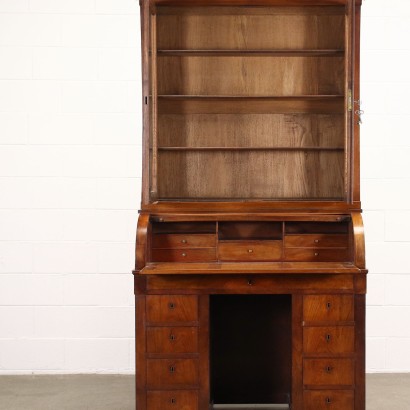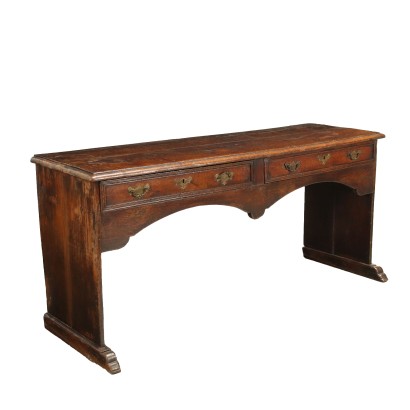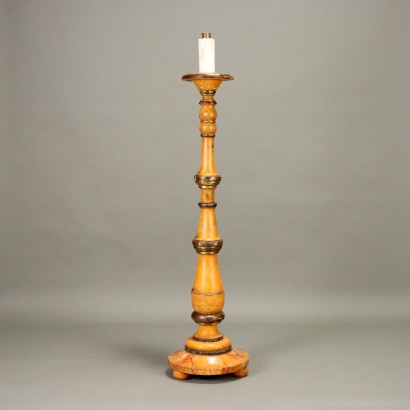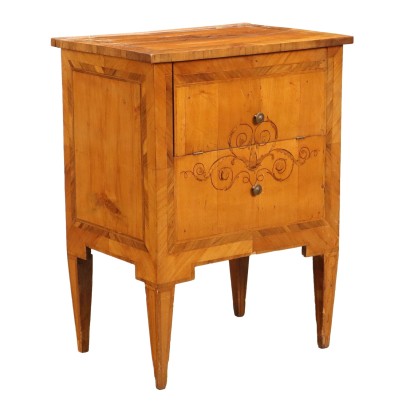Writing Desk with Lift Restoration Mahogany Walnut Glass Italy '900
Features
Style: Bourbon Restoration (1815-1830)
Age: 19th Century / 1801 - 1900
Origin: Italy
Main essence: Mahogany , Walnut
Material: Glass
Description
Restoration Writing desk with lift, on the sides it has two rows of drawers and a large drawer under the top, surmounted by a roller opening door, concealing a cabinet with a pull-out desk top, compartments and drawers. In the upper part raised with two doors equipped with glass and internal rack. In walnut, the interior of the cabinet is veneered in mahogany.
Product Condition:
Product that due to age and usage requires restoration and resumption of polishing.
Dimensions (cm):
Height: 223
Width: 124,5
Depth: 53,5
Additional Information
Style: Bourbon Restoration (1815-1830)
Starting from the Congress of Vienna in 1815, the arts also expressed the return to the monarchical order and the desire for order after the war years.The stylistic features are an evolution of the Empire style, but with simpler lines and stripped of the typical symbols of the Napoleonic period.
There is greater attention to the practicality of furniture and domestic use.
Find out more with the insights of our blog and FineArt on the Restoration style:
The return to the past in the Restoration period < / A>
Gueridon Restaurazione
Age: 19th Century / 1801 - 1900
19th Century / 1801 - 1900Main essence:
Mahogany
It is one of the most precious and sought-after woods in cabinet making. It was discovered in Central America around 1600 and began to be imported to England in the 1700s. Much appreciated for its hardness and indestructibility, it became widespread following the blocking of walnut exports from France in 1720 and the consequent elimination of English import duties on mahogany from the colonies in America and India. The most valuable version comes from Cuba, but it became very expensive. At the end of the 18th century it began to be used also in France in Louis XVI, Directory and Empire furniture, its diffusion declined starting from when Napoleon, in 1810, forbade its import. It was generally used in the manufacture of elegant furniture, due to its characteristics and beautiful grain.Walnut
Walnut wood comes from the plant whose botanical name is juglans regia , probably originally from the East but very common in Europe. Light or dark brown in color, it is a hard wood with a beautiful grain, widely used in antique furniture. It was the main essence in Italy throughout the Renaissance and later had a good diffusion in Europe, especially in England, until the advent of mahogany. It was used for solid wood furniture and sometimes carvings and inlays, its only big limitation is that it suffers a lot from woodworm. In France it was widely used more than anything else in the provinces. In the second half of the eighteenth century its use decreased significantly because mahogany and other exotic woods were preferred.Material: Glass
Other customers have searched:
Ribalte, trumeau, bureau, ribalta con alzata, cassettiera con ribalta, scrittoio, secretaire, stipo..
Dai un'occhiata anche ai nostri approfondimenti sul blog e alle presentazioni dei prodotti FineArt:
Leggi di più
Un cassettone a ribalta, espressione del gusto veronese di pieno Settecento
Secrétaire, il mobile con i nascondigli
Scrittoio a dorso d'asino, Piacenza, metà XVIII secolo
Cassettone a ribalta, Roma, secondo quarto XVIII secolo
Ribalta a urna, Milano metà XVIII secolo
Secrétaire, Bottega Francesco Maggiolini, primo quarto XIX secolo
Secrétaire, “Bottega dei fondi verdi”, inizi XIX secolo
Trumeau con anta a ribalta, Queen Anne, Inghilterra 1705 ca.
Sull'antiquariato in generale dai un'occhiata anche a:
Classic Monday: da un pezzo dei nostri magazzini alla storia dell'antiquariato
L'antiquariato dalla A alla Z: il Dizionario dell'Antiquariato
Il dizionario dell'antiquariato - Lastronatura
Il dizionario dell'antiquariato - Mascherone
Il dizionario dell'antiquariato - Natura morta
Il dizionario dell'antiquariato - Opificio
Il dizionario dell'antiquariato - Pastiglia
Il dizionario dell'antiquariato - Savonarola
Il dizionario dell'antiquariato - Rosone
Intaglio barocco con motivo a ricciolo
Leggi di più
Un cassettone a ribalta, espressione del gusto veronese di pieno SettecentoSecrétaire, il mobile con i nascondigli
Scrittoio a dorso d'asino, Piacenza, metà XVIII secolo
Cassettone a ribalta, Roma, secondo quarto XVIII secolo
Ribalta a urna, Milano metà XVIII secolo
Secrétaire, Bottega Francesco Maggiolini, primo quarto XIX secolo
Secrétaire, “Bottega dei fondi verdi”, inizi XIX secolo
Trumeau con anta a ribalta, Queen Anne, Inghilterra 1705 ca.
Sull'antiquariato in generale dai un'occhiata anche a:
Classic Monday: da un pezzo dei nostri magazzini alla storia dell'antiquariato
L'antiquariato dalla A alla Z: il Dizionario dell'Antiquariato
Il dizionario dell'antiquariato - Lastronatura
Il dizionario dell'antiquariato - Mascherone
Il dizionario dell'antiquariato - Natura morta
Il dizionario dell'antiquariato - Opificio
Il dizionario dell'antiquariato - Pastiglia
Il dizionario dell'antiquariato - Savonarola
Il dizionario dell'antiquariato - Rosone
Intaglio barocco con motivo a ricciolo
Product availability
The product can be seen at Cambiago
Immediate availability
Ready for delivery within 2 working days from ordering the product.


















































